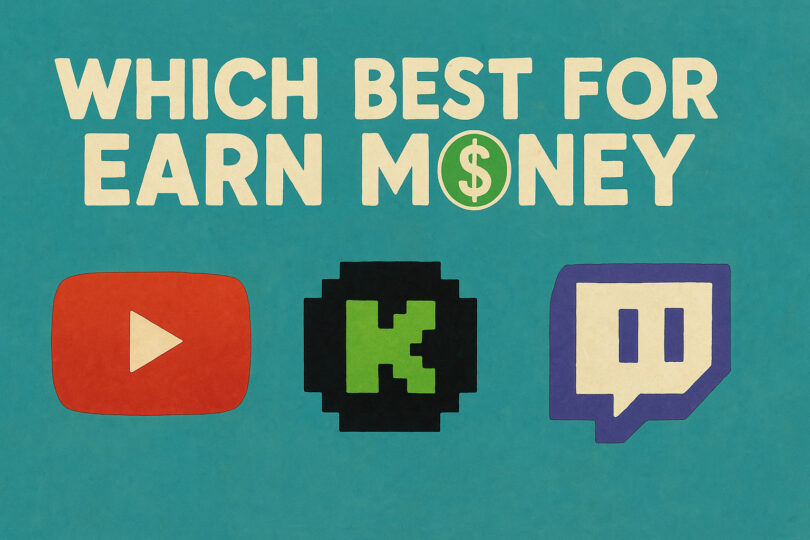Ever wondered how top streamers turn their passion into profit? Whether you’re a gamer, educator, or entertainer, choosing the right live streaming platform can make all the difference. With so many options available—YouTube, Twitch, and newer players like kick—it’s easy to feel overwhelmed. That’s why we’re breaking down everything you need to know about each platform’s monetization models, audience reach, content flexibility, and more. By the end of this article, you’ll know exactly which platform is the best platform for Earn money from live streaming —and how to start earning today.
What You’ll Learn in This Article:
- The key differences between YouTube, Twitch, and kick
- How each platform handles monetization (ads, subscriptions, donations, sponsorships)
- Which platform suits your niche (gaming, education, music, etc.)
- Pros and cons of each platform
- Real-life examples of successful streamers
- Tips to maximize your income through live streaming
Let’s dive in!
Why Choosing the Right Platform Matters for Monetizing Live Streams
Before we compare YouTube, Twitch, and kick, it’s important to understand why the choice of platform matters so much when it comes to making money from live streaming . Each platform has its own ecosystem, audience base, revenue-sharing model, and content guidelines. Your success depends on aligning your goals, content type, and audience preferences with the platform that offers the best monetization opportunities for you.
In this guide, we’ll explore the pros and cons of each service, provide real-world insights, and help you decide which one is the most profitable for your streaming journey.
Overview of the Top 3 Platforms for Earning Through Live Streaming
Here’s a quick snapshot of the three platforms we’ll be comparing:
| Platform | Focus | Key Monetization Features |
|---|---|---|
| YouTube | Broad audience; diverse content | Super Chats, Channel Memberships, Ad Revenue, Brand Deals |
| Twitch | Gaming & creative content | Subscriptions, Bits, Donations, Ads, Affiliate/Premium Programs |
| kick | Niche streaming; global reach | Virtual Gifts, Tips, Sponsorship Opportunities |
Now let’s take a deep dive into each one.
YouTube: The Powerhouse of Diverse Content
YouTube remains one of the most popular video platforms globally, with over 2 billion logged-in users monthly . Its live streaming feature allows creators to engage with audiences in real-time while also generating income through various monetization tools.
Monetization Options on YouTube
- Super Chat and Super Stickers : Viewers pay to pin messages during live streams or send animated stickers.
- Channel Memberships : Fans pay a monthly fee for exclusive perks like badges, emojis, and custom content.
- Ad Revenue : Display ads before and during live streams generate income based on impressions and clicks.
- Brand Partnerships & Sponsorships : Popular creators often collaborate with brands for sponsored content.
- Merch Shelf : Streamers can promote and sell merchandise directly below their videos.
Audience Reach and Growth Potential
YouTube’s vast user base makes it ideal for streamers who want to build a broad following. Whether you’re doing live Q&As, gaming sessions, educational webinars, or music performances, YouTube’s algorithm helps surface your content to new viewers.
Pros and Cons of Using YouTube for Live Streaming
| Pros | Cons |
|---|---|
| 📈 Massive global audience | ⏳ Approval process required for monetization |
| 🎯 Supports diverse content types | 💸 Lower CPMs compared to other platforms |
| 🧩 Integration with Google Adsense | 📉 Slower chat engagement than Twitch |
| 🛍️ Merch integration available | 🕒 Longer time to build a loyal community |
| 📊 Detailed analytics and SEO tools | 📺 Less interactive than Twitch for gaming |
Who Should Use YouTube?
YouTube is perfect for creators who:
- Want to grow organically across multiple niches
- Prefer evergreen content that continues to earn after going live
- Are focused on long-term brand building and diversifying income sources
Twitch: The King of Interactive Live Streaming
Twitch is synonymous with live streaming, especially in the gaming world. Acquired by Amazon in 2014, Twitch boasts over 30 million daily active users , making it the go-to platform for gamers, artists, educators, and IRL (In Real Life) streamers.
Monetization Options on Twitch
- Subscriptions (Twitch Subs) : Viewers subscribe for $4.99–$24.99/month, granting access to exclusive emotes, channel-specific rewards, and perks.
- Bits : A virtual currency viewers use to cheer during streams. Creators earn $.01 per bit used.
- Donations via Third-Party Services : Many streamers link services like PayPal, Streamlabs, or Ko-fi for direct tipping.
- Ads During Streams : Creators can insert short ad breaks and earn revenue based on viewer count and watch time.
- Twitch Affiliate and Partner Program : Offers additional monetization features including custom rewards and higher revenue shares.
Audience Reach and Engagement
Twitch excels in real-time interaction. The chat is fast-paced, and viewers are highly engaged—especially during gameplay. The platform also supports communities, allowing creators to group similar channels and foster collaboration.
Pros and Cons of Using Twitch for Live Streaming
| Pros | Cons |
|---|---|
| 👾 Strong focus on gaming and creative communities | 🎮 Less effective for non-gaming content |
| 💬 High chat interactivity and viewer participation | 🔐 Strict monetization eligibility requirements |
| 🧾 Direct monetization tools (subs, bits, ads) | 📵 No mobile streaming for affiliates/partners |
| 🎁 Custom rewards system | 📉 High competition in popular categories |
| 🤝 Active creator support and events | 🚫 Limited SEO or discoverability outside Twitch |
Who Should Use Twitch?
Twitch is ideal for:
- Gamers looking to build a dedicated fanbase
- Artists, musicians, or IRL streamers with an interactive style
- Creators who thrive in fast-paced, chat-heavy environments
kick: The Rising Star in Global Live Streaming
kick is a relatively new player in the live streaming space but is gaining traction among creators worldwide. It positions itself as a versatile platform that blends elements of social media, live interaction, and monetization tools tailored for diverse content creators.
Monetization Options on kick
- Virtual Gifts : Viewers purchase digital gifts and send them during streams. Creators receive a percentage of the gift value.
- Tips : Direct tipping feature where fans can send money instantly.
- Sponsorship Tools : kick allows creators to connect with brands for sponsored streams and promotions.
- Exclusive Content Access : Creators can offer premium content behind a paywall or subscription model.
- Referral and Creator Incentive Programs : New creators can earn bonuses based on performance metrics.
Audience Reach and Community Building
kick focuses on connecting creators with international audiences. Its lightweight app and cross-platform availability make it accessible even in regions with slower internet speeds. While not as large as YouTube or Twitch, kick’s growing user base offers early adopters a chance to stand out.
Pros and Cons of Using kick for Live Streaming
| Pros | Cons |
|---|---|
| 🌍 Global reach and multilingual support | 📉 Smaller audience compared to YouTube/Twitch |
| 💡 User-friendly interface and mobile-first design | 📊 Limited analytics and reporting tools |
| 🎁 Generous virtual gifting rewards | 🔒 Fewer monetization options at scale |
| 📱 Mobile streaming allowed | 🚫 Less established in Western markets |
| 🧑🤝🧑 Growing creator incentive programs | 📅 Platform still evolving with frequent changes |
Who Should Use kick?
kick is best suited for:
- International creators seeking a mobile-first platform
- Niche streamers in beauty, fashion, fitness, or local entertainment
- Those who prefer a simpler, more gamified monetization experience
Comparing Monetization Models: Which Platform Pays the Most?
When evaluating the best platform for making money from live streaming , it’s crucial to compare how each platform structures its monetization.
| Feature | YouTube | Twitch | kick |
|---|---|---|---|
| Primary Income Source | Ads, Super Chats, Memberships | Subscriptions, Bits, Donations | Virtual Gifts, Tips, Sponsorships |
| Payout Frequency | Monthly | Monthly | Varies by region |
| Minimum Payout Threshold | $100 | $50 | Varies |
| Revenue Share (Est.) | ~55% from ads | ~50% from subs/bits | ~60–70% from gifts/tips |
| Direct Tipping Available? | Yes (via third-party apps) | Yes (via third-party apps) | Yes |
| Mobile Streaming Allowed? | Yes | No (for monetized accounts) | Yes |
While none of these platforms guarantee high earnings immediately, Twitch tends to offer faster monetization for gaming content , whereas YouTube provides broader long-term growth potential . kick , although newer, offers a unique gifting-based economy that can be lucrative in certain markets.
Content Flexibility: Which Platform Lets You Stream Anything?
Another factor to consider is how flexible each platform is regarding the type of content you can stream.
YouTube:
- Best For : Educational content, vlogs, music, gaming, cooking, fitness, tech reviews, and more.
- Content Restrictions : Moderate. Must comply with YouTube Partner Program policies.
- Flexibility : High. Can mix live and pre-recorded content easily.
Twitch:
- Best For : Gaming, art, music, talk shows, and IRL streams.
- Content Restrictions : Moderate. Prohibited content includes sexually suggestive material, violence, and hate speech.
- Flexibility : Medium. Focused primarily on live content.
kick:
- Best For : Beauty, fashion, lifestyle, local entertainment, and cultural performances.
- Content Restrictions : Light. Encourages self-expression within community guidelines.
- Flexibility : High. Mobile-first approach encourages spontaneous streaming.
If you’re a multi-genre creator or enjoy blending formats, YouTube offers the most flexibility . If you’re focused on real-time interaction and community building, Twitch is unmatched . For mobile creators and those targeting global audiences, kick offers exciting potential .
Audience Demographics: Who Uses These Platforms?
Understanding your target audience’s behavior and preferences is essential when selecting a platform.
| Platform | Age Range | Gender Distribution | Primary Use Case |
|---|---|---|---|
| YouTube | 18–55+ | Balanced | Learning, entertainment, discovery |
| Twitch | 18–34 | Male-dominated | Gaming, creative content, community |
| kick | 16–35 | Balanced | Social interaction, live gifting, personal expression |
YouTube appeals to a wide demographic, making it ideal for family-friendly or educational content. Twitch attracts younger audiences, particularly males aged 18–34, drawn to competitive gaming and interactive experiences. kick’s user base is youthful and socially driven, often engaging in live chats and supporting creators through virtual gifts.
User Experience and Interface: Which Is Easier to Navigate?
A smooth user experience is vital for both creators and viewers. Let’s compare how each platform performs in terms of usability.
YouTube:
- Interface : Clean and intuitive.
- Navigation : Easy to find content through search, recommendations, and playlists.
- Creator Tools : Advanced editing, scheduling, and analytics.
Twitch:
- Interface : Chat-centric and vibrant.
- Navigation : Browsable by category, game, or followed channels.
- Creator Tools : Excellent moderation, alerts, overlays, and integrations.
kick:
- Interface : Simple and visually appealing.
- Navigation : Based on trending topics and creator profiles.
- Creator Tools : Basic but improving with updates.
For creators who value customization and control, YouTube and Twitch offer robust toolsets. kick , while less complex, is beginner-friendly and optimized for mobile use.
Technical Requirements and Accessibility
Streaming quality and accessibility depend on technical requirements, mobile compatibility, and regional restrictions.
YouTube:
- Mobile Streaming : Yes (via YouTube Studio)
- Minimum Internet Speed : 3 Mbps upload speed recommended
- Supported Devices : Web, iOS, Android, Smart TVs
Twitch:
- Mobile Streaming : No (for monetized accounts)
- Minimum Internet Speed : 3–6 Mbps upload speed
- Supported Devices : Web, iOS, Android (limited), OBS, Streamlabs
kick:
- Mobile Streaming : Yes
- Minimum Internet Speed : Low bandwidth supported
- Supported Devices : iOS, Android, Web
If you plan to stream on-the-go or have limited internet access, kick and YouTube are your best bets. Twitch requires more setup and isn’t mobile-friendly for monetized creators.
Community and Interaction Features
Engaging with your audience is critical for building loyalty and increasing earnings. Let’s see how each platform fosters community.
YouTube:
- Live Chat : Yes, but slower and less dynamic
- Community Tab : Yes (posts, polls, updates)
- Fan Funding : Super Chat and Memberships
Twitch:
- Live Chat : Fast, customizable, and integrated with alerts
- Rewards System : Customizable points and challenges
- Community Channels : Guilds, teams, and shared spaces
kick:
- Live Chat : Yes, with emojis and reactions
- Fan Engagement : Virtual gifts and comments
- Social Sharing : Built-in sharing features for followers
Twitch wins in real-time interaction, especially for gaming and fast-paced content. YouTube offers more structured community-building tools, while kick emphasizes emotional connection through gifting and feedback.
Marketing and Discoverability
Getting discovered is easier on some platforms than others. Here’s how YouTube, Twitch, and kick handle visibility.
YouTube:
- SEO-Friendly : Highly searchable due to Google integration
- Algorithm : Recommends based on watch time and engagement
- Cross-Promotion : Easy to share on social media
Twitch:
- Discoverability : Game categories and follower feeds dominate
- Trending Section : Curated by Twitch for featured content
- Promotions : Paid boosts and affiliate marketing
kick:
- Discovery : Trending lists, hashtags, and creator profiles
- Viral Potential : High for engaging and entertaining content
- Community Sharing : Encouraged through likes, shares, and tags
YouTube’s SEO strength gives it an edge in long-term discoverability. Twitch relies heavily on follower networks and real-time trends. kick thrives on viral content and peer-driven sharing.
Case Studies: Successful Streamers on Each Platform
YouTube Success Story – MrBeast
Jimmy Donaldson, better known as MrBeast, started with gaming content and now produces elaborate stunts and charity challenges. His live streams often attract millions of viewers and generate significant ad and sponsorship revenue.
Twitch Success Story – Shroud
Michael Grzesiek, a former CS:GO pro, became one of Twitch’s top earners through subscriptions, sponsorships, and brand deals. He later moved to YouTube but built his initial wealth on Twitch.
kick Success Story – Unknown Asian Influencer
Many emerging creators in Asia have found financial success on kick through virtual gifts and brand partnerships. One such creator earned over $10,000 in a single month by hosting daily dance and lifestyle streams.
These case studies show that success depends more on strategy and consistency than the platform alone .
How to Choose the Right Platform for You
Choosing the best platform for making money from live streaming depends on several factors:
- Type of Content : Gaming favors Twitch; educational or mixed content suits YouTube; expressive or local content thrives on kick.
- Audience Location : YouTube and Twitch are strong in Western markets; kick has growing appeal in Asia, Africa, and Latin America.
- Monetization Goals : Twitch offers quicker returns for interactive content; YouTube builds long-term passive income; kick excels in gift-based earnings.
- Technical Setup : Twitch requires more advanced equipment; YouTube balances ease and flexibility; kick is mobile-friendly.
- Growth Strategy : YouTube favors SEO and evergreen content; Twitch prioritizes real-time engagement; kick leans on virality and social sharing.
Consider starting on multiple platforms using cross-streaming tools like Restream or StreamYard to test what works best for your audience.
Final Verdict: Which Platform Is the Best for Making Money from Live Streaming?
There’s no one-size-fits-all answer, but here’s a summary to help you decide:
| Criteria | Best Platform |
|---|---|
| Fastest Monetization | Twitch |
| Long-Term Passive Income | YouTube |
| Global Reach & Mobile Streaming | kick |
| Interactive Chat & Community | Twitch |
| SEO & Evergreen Content | YouTube |
| Gift-Based Earnings | kick |
Our Recommendation:
- Gamers and Interactive Creators : Go with Twitch .
- Educators, Vloggers, and Multi-Niche Creators : Stick with YouTube .
- Mobile-First or International Streamers : Try kick .
Ultimately, the best platform for making money from live streaming is the one that aligns with your content style, audience preferences, and long-term goals.
Tips to Maximize Earnings Across All Platforms
Regardless of where you choose to stream, here are actionable tips to boost your income:
- Engage Consistently : Build a routine schedule so viewers know when to tune in.
- Interact with Viewers : Respond to comments, thank donors, and create a welcoming environment.
- Use Alerts and Overlays : Enhance the viewing experience with visual cues for donations, subscriptions, and gifts.
- Promote Across Social Media : Drive traffic from Instagram, Twitter, TikTok, and Facebook.
- Collaborate with Other Creators : Cross-promote and tap into new audiences.
- Offer Exclusive Perks : Reward loyal fans with behind-the-scenes content or shoutouts.
- Track Analytics : Understand peak times, drop-off points, and viewer demographics.
- Diversify Income Sources : Combine platform earnings with affiliate marketing, merch sales, and brand deals.
Remember: Consistency, authenticity, and engagement are the keys to long-term success in live streaming.
Frequently Asked Questions (FAQ)
Q1: Which platform pays the most for live streaming?
A : It varies by content type and audience size. Twitch generally pays well for gaming, YouTube for diverse content, and kick for gift-based earnings.
Q2: Can I stream on multiple platforms at once?
A : Yes! Use tools like Restream, StreamYard, or Restream.io to broadcast simultaneously to YouTube, Twitch, and kick.
Q3: Do I need special equipment to start streaming?
A : Not necessarily. You can start with just a smartphone and stable internet. As you grow, invest in a webcam, mic, and lighting.
Q4: How do I get verified or monetize on these platforms?
A : Each platform has specific requirements. Typically, you must meet view/time thresholds, follow guidelines, and apply for monetization.
Q5: Is live streaming a sustainable career?
A : Absolutely! Many full-time streamers earn six figures annually through a combination of ads, subscriptions, donations, and sponsorships.
Conclusion: Start Streaming and Start Earning Today
The world of live streaming offers incredible opportunities for anyone willing to put in the effort. Whether you’re drawn to Twitch’s vibrant gaming culture, YouTube’s massive reach and SEO power, or kick’s mobile-friendly and gift-driven economy, there’s a place for every creator.
By understanding the strengths and weaknesses of each platform, you can make an informed decision on the best platform for making money from live streaming . And remember—you don’t have to stick to just one. Experiment, learn, and adapt as you grow.
So grab your camera, set up your microphone, and start broadcasting. Your next big opportunity could be just one live stream away.








Leave a Comment